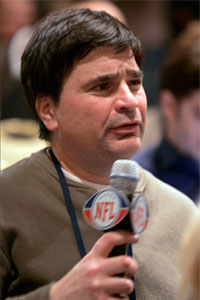Newsletter of the Milwaukee Newspaper Guild
Contract bargaining to begin in June
If it seems like it hasn’t been that long since we were in negotiations, you’re right.
The Milwaukee Newspaper Guild signed our last contract with Journal Sentinel Inc. in June 2010. We start bargaining the next one this June.
While our negotiations are often lengthy, bargaining on the 2009-’11 contract was particularly unusual because of long gaps in which we had to deal with a 6.6% wage cut and a wave of layoffs and buyouts, at the same time the company was reconsidering its strategy and reorganizing its bargaining team.
We expect – and hope – this will be a more normal round of bargaining, with the notable exception that for the first time, we’ll be negotiating to restore wages that have been reduced. Our members have made it clear that full restoration of our previous wage levels must be one of our highest priorities.
Leading our bargaining committee will be metro reporter Larry Sandler. He’s our most experienced negotiator, having played a role in bargaining every contract in the past 20 years, including three previous stints as chair. He’s also a former vice president and handles jurisdiction and job posting issues. Other committee members are Local 51 President Tom Silverstein, a sportswriter who was on the last bargaining team; business reporter Doris Hajewski, a steward who served on our local’s first Executive Board; and business reporter Don Walker, a founding member of our local. Second Vice President Karen Samelson, a copy editor, will join the committee periodically, as she did in the last round of bargaining.
Committee members have already conducted a series of small-group meetings and an electronic survey to gauge members’ views on the issues likely to arise at the bargaining table. A solid majority of dues-paying members participated in either the meetings, the poll or both, to give the committee a good idea of the membership’s priorities. Our contract expires Dec. 31. If we have not ratified a new contract by then, the contract will be automatically extended while negotiations continue.
Treasurer post up for vote at May 17 meeting
Milwaukee Newspaper Guild members will vote on a possible Executive Board switch at our membership meeting at noon May 17 at Turner Hall.
We’ll hold a special election to replace Treasurer Amy Hetzner, who has decided to step down after about five years in that job. Atlarge board member Bob Helbig, who served as treasurer for a record seven years in two previous stints, is running for the four months remaining in Hetzner’s term.
If Helbig is elected treasurer, we’ll vote to fill his board seat. Hetzner plans to run. Other nominations for both posts will be accepted from the floor. We’ll also discuss what’s ahead as bargaining starts. Lunch will be served.
Pay restoration strays from expectation
It’s always good news to see more money in our paychecks. But it would have been better news if Journal Sentinel Inc. had labeled it and treated it as we believe our contract says it should be handled.
At the time Milwaukee Newspaper Guild members agreed to a 6.6% wage cut, we also agreed to language that said our wages would be restored in proportion to the amount restored to nonunion staff, who took a 6% cut. We understood that to mean that for every 1% of their old wage that they got back, even on a merit basis, we would get back 1.1% of our old wage across the board.
But that’s not exactly what happened. The non-union staff is getting merit raises from a pool that equals 2% of their most recent pay rates. And all of us who took a 6.6% cut received an across-the-board increase of 2.2% of our most recent pay rates, effective April 3, on the first paycheck in April.
That’s not precisely proportional, because their most recent pay was 94% of their old pay and ours was 93.4% of our old pay, so their increase was 1.88% of old pay and ours was 2.055% of old pay. If it was a 1-to-1.1 proportion of old pay, we should have received 2.068% of old pay, which works out to 2.214% of most recent pay. The difference is not a lot of money, probably less than $10 a year for most members of our bargaining unit and well under $2,000 a year for all of us together.
Perhaps more significant, however, is that management calculated it as if our most recent pay was the base and this was a raise from that base. They even called it a raise, when we believe it should more accurately be called partial restoration of the wages that were cut.
We argued that three 2.2% raises from most recent pay would not restore all of the 6.6% of old pay that we lost — a point we also made, and thought was understood, at the time the language was incorporated into the contract. Management agrees and says it remains their intention for us to get back all of that 6.6% … eventually. This is likely to be an important issue in bargaining on the next contract.
The pay restoration affects a few groups differently:
- Since the pay cut, anyone who was due to move up on the wage scale, or who was promoted, has moved to 93.4% of the minimum for their new pay step. With the 2.2% increase, that percentage now becomes 95.6%. This is in the contract and management is abiding by it.
- Some of our bargaining-unit members were previously in non-represented positions and took a wage cut of 6%, rather than 6.6%. Those people received 2% increases across the board. This was an unwritten understanding that management is following.
- A very small number of our bargaining-unit members have received merit raises since the pay cut. We have an unwritten understanding with management that these merit raises do not count toward restoration, meaning that whenever we get the full 6.6% back, those people will have their old wage plus their merit raise.
Guild celebrates hard work with fish fry
[nggallery id=1]
Have you been working too hard lately for 6.6% less?
Yes, Local 51’s board thought so, too.
After wrestling with a Super Bowl, a blizzard and never-ending turmoil in Madison, the Guild threw a party April 14 to reward members for their hard work on behalf of the Journal Sentinel.
The event was a traditional fish fry at Buck Bradley’s, where about 40 members and significant others showed up to chat, eat and drink free beer. Numerous night-shift workers even managed to get across the street on their dinner breaks.
Thanks go to Jan Uebelherr for hatching the fish fry idea and pursuing it until she’d landed a deal at Buck’s, and to Zeina Makky for designing catchy fliers.
New Guild committee recognizes life events
Sometimes the best thing we can do is just pay attention. That’s the idea behind the Guild’s new Good & Welfare Committee.
When bad things happen — a colleague or former colleague is ill or there’s a death in someone’s family — it’s just good to pay attention. We want to celebrate good things, too, like new babies.
Often that will mean just a card. Sometimes it might mean help with meals or chores. The goal is not to duplicate traditional newsroom efforts, but to acknowledge what is happening in the lives of our co-workers.
If you know of someone who could use a little union support, let us know. Committee members are Amy Rabideau Silvers, Gina Barton, Nick Lujero, Mary-Liz Shaw and Jan Uebelherr. All of this is something of a work in progress, but we look forward to your suggestions and involvement as we try to pay attention.
Newsroom wins third Pulitzer in four years
For the third time in the past four years, the Journal Sentinel has won a Pulitzer Prize, and for the third time, the reporters were longtime Guild members.
Reporters Mark Johnson and Kathleen Gallagher, photojournalist Gary Porter, graphics editor Lou Saldivar and interactive producer Alison Sherwood won a Pulitzer for explanatory reporting on April 18.
Johnson has been a board member and steward leader and is now a steward; Gallagher is the benefits coordinator.
Their three-part series with video and interactive graphics, “One in a Billion: A boy’s life, a medical mystery,” was about groundbreaking efforts by doctors and researchers at the Medical College of Wisconsin to sequence the DNA of 4-year-old Nic Volker to come up with potentially lifesaving treatment. The series can be found at jsonline.com/dna.
Others working on the project were projects editor Greg Borowski, health and sciences editor Becky Lang, visuals editor Ed Brud, copy editor Karen Samelson and copy chief Pete Sullivan. Brud is a Guild member and former steward leader; Samelson is the second vice president.
Executive pay jumps as we fight for 6.6%

From the president
Many of us did a double take when we read in our own newspaper a report that detailed the compensation increase Chairman of the Board and CEO Steven J. Smith received. According to the company, Smith received $2 million in compensation in 2010.
The figure itself isn’t what stands out; it’s the 39.7% increase from his compensation in 2009 that created such a buzz in the newsroom. This occurred during a year when our wages remained stuck at the minus-6.6% level of 2009 and we were continually told to do more with less.
None of us has been happy about losing 6.6% of our pay, but it hasn’t affected the way we go about putting out an award-winning news-
paper. I, like many others, was under the impression that when the company was back on its feet it would reward its newsroom staff for the sacrifice it made in 2009.
Apparently, I was wrong.
Smith wasn’t the only one who earned an increase in compensation. On average, the top five corporate executives received a 28% increase in 2010 from their previous year’s compensation. Furthermore, the four top executives who have been here since 2007 have seen total compensation rise by 20% over their pre-wage cut salaries, mainly through various types of bonuses. We, in the meantime, received a one-time 2% bonus and no restoration of our 2009 salary cut in 2010.
News of this discrepancy is like a gut punch to those of us who have taken on more work since the massive layoffs of 2009 and hoped the company would do right by us for that effort. We all saw that profit for 2010 was up $34.4 million, up 698% from the year before. Yet, it took the company until mid-April to even address partial restoration.
As a result of this double standard, the 6.6% committee and I crafted a letter to Smith and Publisher Betsy Brenner to express our concern with this disparity and to make a statement that I think reflects the feeling of our membership. This excerpt from the letter may sum things up best:
“It was very disconcerting to see where we rank when it comes to rewarding hard work.”
We told both Steve and Betsy that we did not take the 2% restoration they gave us in April lightly and that we appreciated that step in the right direction. But we also pointed out it did not compare to the executives’ increases.
To cap off the letter we asked the executives for two things:
“Please explain how the top executives could receive an increase in compensation averaging 28% when the front-line workers represented by Local 51 are slated to receive a partial pay restoration of only 2%.
“Please tell us when we can expect the rest of our 6.6% pay cut restored.”
I’m not sure when or if we’ll hear back from Steve and Betsy, but I would like all Guild members to know that we are committed to pursuing fair treatment in the workplace and fighting this disparity in restoration.
